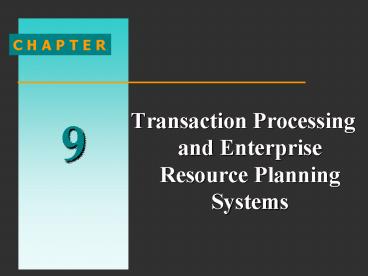C H A P T E R - PowerPoint PPT Presentation
Title:
C H A P T E R
Description:
One of the first business processes to be computerized ... (e.g. bar code scanners) Examples of data collection? Transaction Processing Cycle ... – PowerPoint PPT presentation
Number of Views:22
Avg rating:3.0/5.0
Title: C H A P T E R
1
C H A P T E R
9
- Transaction Processing and Enterprise Resource
Planning Systems
2
Goal of Transaction Processing
- Provide all the information needed to keep the
business running properly and efficiently. - Provide timely documents and reports
- Provide data for other systems
- Safeguard information
3
Characteristics of Transaction Processing
- One of the first business processes to be
computerized - Performs routine operations on a regular basis
- Provides data to other systems
- High level of detail, accuracy, security
- Limited support for decision making
- A lot of input and output large storage needs
- Limited sophisticated or complex processing
4
TPS, MIS, DSS, and AI/ES
5
The Steps in TPS(Transaction Processing Cycle)
- Data Collection
- Data Editing
- Data Correction
- Data Manipulation
- Data Storage
- Document Production
6
An Overview of TPS
- The input includes basic business transactions
- The result is that the organizations records are
updated to reflect the status of the operation at
the time of the last processed transaction.
7
Batch vs. On-Line Transaction Processing
Batch Processing (original) A system whereby
business transactions are accumulated over a
period of time and prepared for processing as a
single unit or batch.
On-Line Transaction Processing (OLTP) A system
whereby each transaction is processed
immediately, without the delay of accumulating
transactions into a batch. Always current.
8
Transaction Processing Cycle Data Collection
- Begins with a transaction (e.g. an order)
- Manual or automated
- Source Data Automation
- (e.g. bar code scanners)
- Examples of data collection?
9
Transaction Processing Cycle Data Editing
- Validity and completeness
10
Transaction Processing Cycle Data Correction
- Feedback regarding errors
- Opportunity to re-enter
11
Transaction Processing Cycle Data Manipulation
- Performing calculations
- Classifying
- Sorting
- Summarizing
12
Transaction Processing Cycle Data Storage
- Updating databases
- An output of TPS
- Input to all other systems
13
Transaction Processing Cycle Document Production
- Paychecks
- Invoices
- Packing slips
- etc.
14
Control Issues
- Business Resumption Planning
- Identify threats
- Disaster Recovery
- Identify solutions
- Backups
- Hot sites
- Cold sites
- System Audits
- Create an audit trail
15
Traditional TPS Applications
- Order Processing
- Purchasing
- Accounting
16
Order Processing Support Systems
- Order Entry
- Captures the data
- Suggests substitute, related, or add-on items
- Sales Configuration
- Ensures that products and services ordered will
work together to accomplish customers objectives - Suggests options and eliminates mistakes
17
Order Processing Support Systems
- Shipment Planning
- Determines which open orders will be filled and
from which location they will be shipped and by
what means. - Prepares a pick list
- Shipment Execution
- Coordinates and confirms the outflow of all
products and goods from the organization
18
Order Processing Support Systems
- Inventory Control
- Updates the computerized inventory records to
reflect the exact quantity on hand of each stock
keeping unit. - Minimizes cash tied up in inventory
- Often bar-coded (www.milk.com/barcode)
- Just as important for service industries (e.g.
airlines)
19
Order Processing Support Systems
- Invoicing
- Generates customer invoices based on records
received from the shipment execution TPS - Customer Interaction
- Monitors and tracks each customer interaction
with the company. - Contact Management
20
Order Processing Support Systems
- Routing
- Determines the best way to get goods and products
from one location to another. - Tracking (UPS, FedEx)
- Scheduling
- Determines the best time to deliver goods and
services.
21
What is Enterprise Resource Planning?
- A collection of software packages, which ties all
of an enterprise's various functions into a
cohesive database. These packages affect
everything from order capture to accounting and
procurement to warehousing. - Employees enter information only once and that
information is then available to all systems
company-wide. - This means everyone in the company can make
decisions based on accurate, real-time
information.
22
For Example
- The sales force enters an order on a computer,
and the transaction propagates through the entire
company. - Inventory lists and parts supplies are updated
automatically, worldwide. - The ERP system determines whether the product
should come from current finished goods in a
warehouse, work in process, scheduled production,
or new production.
23
For Example, contd.
- Production schedules and balance sheets will
reflect the changes. - Best of all, every employee has only the
information necessary for the job at hand - Salespeople can promise firm delivery dates
- Managers can gauge almost immediately the effects
of decisions affecting credit terms, discounts,
inventory, or supply-chain management.
24
Enterprise Resource Planning
- Real-time monitoring of business functions,
permits timely analysis of - Quality
- Availability
- Customer satisfaction
- Performance
- Profitability
25
ERP Advantages
- Replace dozens of legacy applications with one
integrated set - Ensures best business practices
- Provides improved access to integrated,
company-wide data - Simplifies and standardizes technology
infrastructure
26
ERP Disadvantages
- Expensive, disruptive, and time-consuming
- May require dramatic changes in work processes
- Difficult to integrate with other systems
- Wedded to one vendor
- Necessitates consultants































